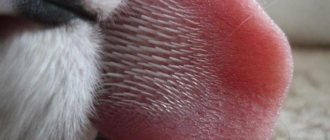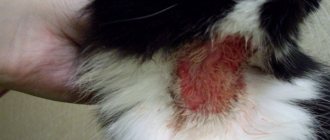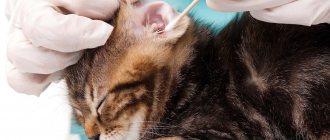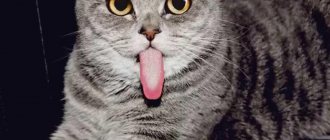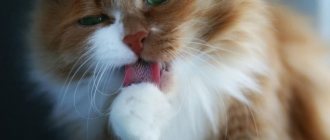Main causes of spotting
Black spots in a cat's mouth occur due to the influence of various factors that determine the type of disease.
Acne
Acne looks like dark rashes or small pinkish pimples. They are located outside - around the mouth area, on the lower lip.
The favorite place to appear is the chin, as the sebaceous glands actively work there.
Causes:
- Incorrect feeding. For example, giving food from the table. This leads to an imbalance of nutrients, a lack of vitamins, microelements and other useful elements.
- Pet uncleanliness. Often cats do not remove the remaining food from their faces, which provokes inflammation of the skin.
- The influence of stress factors.
- Response to irritation by an allergen. It appears as a rash in areas of interaction with the irritant.
- Negligent attitude of the owners towards the cleanliness of the bowls.
- Genetic disease.
The first 5 reasons can be eliminated, then the animal will return to normal. With the hereditary transmission of dark rashes, you will have to come to terms with the fact that they will not go away. They will also not cause harm to the cat's health.
Symptoms : dark acne; inflammatory reaction on the mucous membrane of the lower lip; suppuration and swelling of rashes; the appearance of crusts in the oral cavity. Acne occurs from time to time, but more often it is chronic.
Lentigo
The most likely cause of dark spots in a cat's mouth. In this case, the stains are harmless. They are characteristic not only of animals, but also of humans. Lentigo appears in adult animals in the form of small pigmented areas. Whereas in kittens, the oral cavity is the same shade, clean. With age, the size and number of spots increase.
Localization of skin defects - gums, palate, nose, lips, chin. Type of spots: on the same level with the mucous membrane or skin, smooth surface, no itching, peeling, pain, or discomfort.
Red and spotted cats are susceptible to lentigo. You can compare them to freckles in humans.
Fungus
Fungal diseases are rare. The cause is the development of fungi with a decrease in the body's defenses. This explains the manifestation of symptoms in kittens, weakened after operations, and elderly animals.
There are no specific signs. The fungus is characterized by the appearance of crusts and dark spots.
Mycoplasmosis
Another disease that is caused by an opportunistic organism with decreased immunity.
It has specific symptoms: inflammation of the conjunctiva, discharge of pus from the eyes and nose, refusal to feed, pigmentation of the oral mucosa. The spots are located on the lips, tongue and around the mouth.
Oncology
Develops in older cats. It appears as dots and black spots on the gums and mucous membranes, and is a sign of melanoma. This is a malignant neoplasm. In addition to external signs, there is loss of appetite, apathy, and an exhausted appearance.
Pellagra
A disease caused by a lack of vitamin PP and B6 is called pellagra. In cats, this pathology is quite rare and is associated with a monotonous diet. In most cases, hypovitaminosis occurs in animals that eat low-quality dry food in a low price segment.
You might be interested in: Why does a cat have a constantly wet chin?
The composition of such feeds is not balanced and does not always meet the needs of the animal’s body for certain vitamins. Pellagra can also be encountered by street animals that do not have a regular diet and eat whatever they can find. Often cats taken from the street suffer from hypovitaminosis, and the owners cannot immediately understand the reason for the lethargy and drowsiness of their furry pet, as well as dark spots on the tongue.
Pellagra in cats appears as spots on the mucous membranes of the mouth, sometimes spots on the tongue, nose and ears. To make an accurate diagnosis, you should consult a veterinarian, since plaque in the ears and nose may be the result of tick-borne infestation, and spots on the tongue may turn out to be harmless pigmentation.
If the diagnosis is confirmed, treatment is carried out by adjusting the diet. It is recommended to purchase special vitamin supplements for cats, depending on the age of the pet. If the cat eats natural food, the following products should be introduced into the diet:
- liver;
- kidneys;
- sea fish;
- milk;
- carrot.
These products are rich in vitamin PP and quickly eliminate its deficiency. To achieve the best effect, it is necessary to combine a therapeutic diet with taking special vitamin supplements. The recommended dosage of vitamins PP and B6 is up to 5 mg per kilogram of pet weight.
Diagnosis and treatment
Although pigmentation in most cases is not dangerous, you should take your pet to the veterinarian . He will establish the exact cause using a visual examination, laboratory tests, and examination of the mucous membrane for bacterial contamination. Treatment:
- With acne, it is enough to get rid of the cause that caused the rash. The animal's condition will return to normal.
- Lentigo is a congenital manifestation, so no treatment is required.
- For fungal diseases, antiseptics are prescribed for rinsing (Stomadex, solutions of Chlorhexidine, hydrogen peroxide, furatsilin) and antifungal agents (potassium iodide, Clotrimazole, Amphotericin).
- Mycoplasmosis - therapy consists of restoring the immune system, giving antibiotics (Ofloxacin, Azithromycin), treating the oral cavity (Ribotan, Cycloferon). Probiotics and Feliferon injections can be prescribed.
- Oncological diseases often remain untreated.
For any reason, it is mandatory to include vitamin-mineral complexes in the diet.
Changing tongue color
The color of the mucous membranes depends on the filling of the blood with carbon dioxide and oxygen. If there is a deficiency, the cat's tongue becomes bluish in color. This phenomenon is called cyanosis. If it is long-lasting and persistent, then the cat will feel worse and worse – to the point of death. The blue color can become dark, almost black, or purple-red.
© shutterstock
Why doesn't a blue tongue always indicate illness? A cat can simply lick a blue item, and the stuck lint will visually change color. In another case, the animal may accidentally lick blueberry juice or dyes. They will temporarily turn the tongue an unnatural color.
Additional symptoms
A situation often occurs when, with such a manifestation, the animal still does not eat.
A cat's tongue has a black tongue or a blue coating on it, as a rule, occurs against the background of serious diseases of various organs and systems. In case of deviations, the following signs are observed:
- severe shortness of breath not associated with physical activity;
- protruding tongue;
- restless state;
- lethargy;
- lack of appetite.
Black spots on a cat's tongue, what are they? Are black spots on a cat's tongue dangerous?
In fact, external manifestations of this kind are not always a cause for concern, and the text below will help you figure out when you really should panic, and when, on the contrary, you should relax and “let go” of the situation.
For example, most often black spots on the tongue of cats appear as a kind of pigmentation, often affecting the rough surface of the palate. In addition, there are often situations when a cat develops black spots on its tongue not from birth, but already in adulthood, gradually increasing in number and size. Certain types of furry purrs are especially susceptible to such external symptoms, and we are talking not only about the breed, but also about the color of their coat. For example, pets with red hair are much more likely to develop this kind of pigmentation, which, by the way, is not always black. Quite often, the spots immediately or over time acquire a dark blue or even brownish tint, and this is also not some kind of pathological process.
When discussing the topic of the appearance of black spots on a cat’s tongue, it would be wrong not to mention such a safe formation as lentigo. Experts say that such spots are also a kind of pigmentation, which is directly related to freckles, but only of a dark color. There are two types of lentigo: simplex and profusa, and if in the first case we are talking about single foci, then the second involves multiple formations with a fairly large affected area. Such dark “freckles” also most often affect ginger cats, and no specialist can still explain the reason for their manifestation. At the same time, lentigo is not a dangerous pathology and therefore does not require any treatment, although neoplasms often affect not only the tongue, but also the nose, lips and other parts of the pet’s face.
It is quite natural that no one except a specialist will be able to immediately determine that a cat has a black tongue due to lentigo. And it’s better not to try to make independent diagnoses, so as not to let a much more serious pathology take its course, mistaking it for a cosmetic defect.
And even if the doctor confirms the safety of the black spots formed on the cat’s tongue, he may additionally prescribe a biopsy for the pet. This analysis is necessary to exclude malignant tumors in a pet such as melanoma. If the biological material sent for examination does not give any negative results, then we can assume that the pet escaped with a slight fright and does not need additional therapy. Unfortunately, a less positive prognosis would be appropriate if the cat’s black tongue is a consequence of a fungal infection.
So, quite often, pathogenic bacteria settle on untreated wounds or scratches that appear inside the animal’s mouth for some reason, and if its immune system is weakened at that moment, then they can easily provoke a real fungus. As a rule, an already difficult situation can be aggravated by multiple ulcers, the formation of rotting scabs, a dark or, on the contrary, whitish coating and a rather noticeable painful syndrome.
Correcting this situation is not as simple as it might seem at first glance and will most likely require a long course of treatment. Moreover, in addition to antifungal and antiseptic drugs, various vitamins and medications will be needed to strengthen the animal’s weakened immune system. As an option, you can try to take a course of special homeopathic medicines designed to restore the vitality of animals and, as an example, it is advisable to use domestically produced medicines.
Sometimes overly responsible owners of four-legged pets have quite funny incidents. For example, some of them may consider black spots on a cat’s tongue, which are actually a coating of ordinary dirt, to be a dangerous disease.
And all because a surface that is too rough can retain particles of dark, overly pigmented or colored food, as well as all kinds of debris for some time, and this is not a reason to immediately panic if a cat has a black tongue.
In what cases should you contact a veterinarian?
Black dots and spots on the cat's face and mouth (on the tongue and gums), even if they are just acne or moles, are a sufficient reason to contact a veterinarian. Any change in the skin creates a hotbed for bacterial or fungal infections, and only a specialist can exclude serious diagnoses with similar symptoms.
Timely treatment avoids complications and supports the cat’s immune system in the fight against infectious diseases. Even such a terrible diagnosis as melanoma is not a death sentence. If detected in the early stages, surgical removal and consolidation of the result with chemotherapy is possible.
Cats are very clean animals that keep their bodies clean, including their tongues. The appearance of black plaque can be a normal physiological state of the animal or a symptom of diseases of the internal organs. If other warning signs appear, it is recommended to consult a veterinarian. Next, we will take a closer look at the main reasons for the appearance of black tongues in cats.
Glossitis
Superficial inflammation of the tongue, or its internal tissues, is most often a symptom of an internal disease. An inflammatory process in the mouth may result from:
- dental problems;
- damage to the tongue and the addition of microbes;
- infectious diseases;
- pathologies of the gastrointestinal tract.
The coating on the tongue takes on an unusual color. Such a symptom is quite valuable for establishing the real picture of the disease. Additionally, hypersalivation (increased salivation) and unpleasant odor from the pet’s mouth are noted.
Treatment should be aimed, first of all, at the root cause of glossitis. Because as an independent pathology, such a problem (inflammatory process in the tongue) is extremely rare.
Causes of acne in cats, methods of treatment and prevention
Scattered black dots, which usually do not bother your cat, indicate mild acne. Over time, redness and swelling appear around the acne, and inflammation begins with the formation of pustules. When a cat feels itching or pain, it scratches its chin, which can lead to hair loss. If you ignore the disease at this stage, the number of acne will increase, hard pustules will form and the risk of developing a severe form increases: the pustules will merge, forming deep nodes, the skin will begin to thicken, and open wounds may form.
Etymology (causes and conditions of occurrence) of acne and preventive measures:
Acne in cats
- Genetic predisposition can lead to increased activity of the sebaceous glands, which increases the risk of acne. In this case, you need to regularly use products that dry and cleanse the skin.
- Plastic food and water bowls, due to their porous structure, become a breeding ground for bacteria that cause infection and inflammation of the skin of the chin. There have been cases when replacing them with stainless steel containers completely solved the problem of rashes on the face. There is an assumption that the appearance of acne may also be an allergic reaction to plastic. Acne can also appear as a result of food allergies.
- Stress causes the release of adrenaline and cortisol, which stimulate the sebaceous glands, creating fertile ground for the formation of acne and pimples.
- Unbalanced diet. The appearance of black dots should be a signal to revise the diet towards reducing fat and enriching the diet with vitamins.
- It is difficult for a cat to keep its chin clean on its own. Washing with warm water after eating will remove the problem of contamination. Your pet's dishes should be washed daily with hot water and soapy water.
Treatment
Liver diseases
Toxoplasmosis
Various injuries.
Breathing with an open mouth.
This behavior is not typical for representatives of the cat family. Sometimes cats may breathe with their mouths open after vigorous play or hyperactivity. But it doesn't last longer than a couple of minutes. If a cat sticks out its tongue, breathes heavily and frequently, or suffocates, then this is a cause for concern.
This is a sign of respiratory failure, as well as oxygen deficiency in the lungs and tissues. At first, the mucous membranes and tongue may become very red, and then turn blue.
Cough.
It indicates the body's attempts to remove mucus and fluid from the alveoli. This process is reflexive in nature. The cough with edema is always wet, with expectoration of sputum, mucus and sometimes blood.
Decreased activity.
The article was read by 1,999 pet owners
- A red or bluish tint to the tongue, gums, lips and skin may indicate blood disorders.
- Worsening or difficulty breathing
- Coloration of paw pads bluish or reddish.
When your cat develops cyanosis and you, not knowing what to do, are looking for advice on this topic on the Internet on forums, we recommend not to self-medicate or experiment on your beloved cat. The fact is that there are many reasons for cyanosis in an animal, and the consequences of your experiment may disappoint you and your family.
Treatment of this disease depends on the established diagnosis.
- Surgery is required for congenital heart disease.
- If hemoglobin is low, drug treatment is prescribed.
- For breathing problems that cause cyanosis and may be caused by pneumonia or chronic bronchitis, antibiotics are prescribed
- When fluid stagnates in the lungs, diuretics are prescribed.
- A thoracentesis (surgical procedure) is performed to remove fluid or air from the chest.
- Supply of oxygen when there is a shortage.
